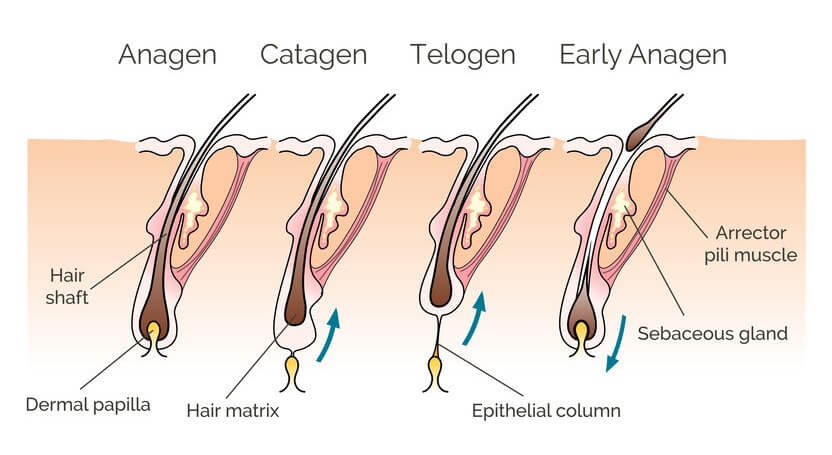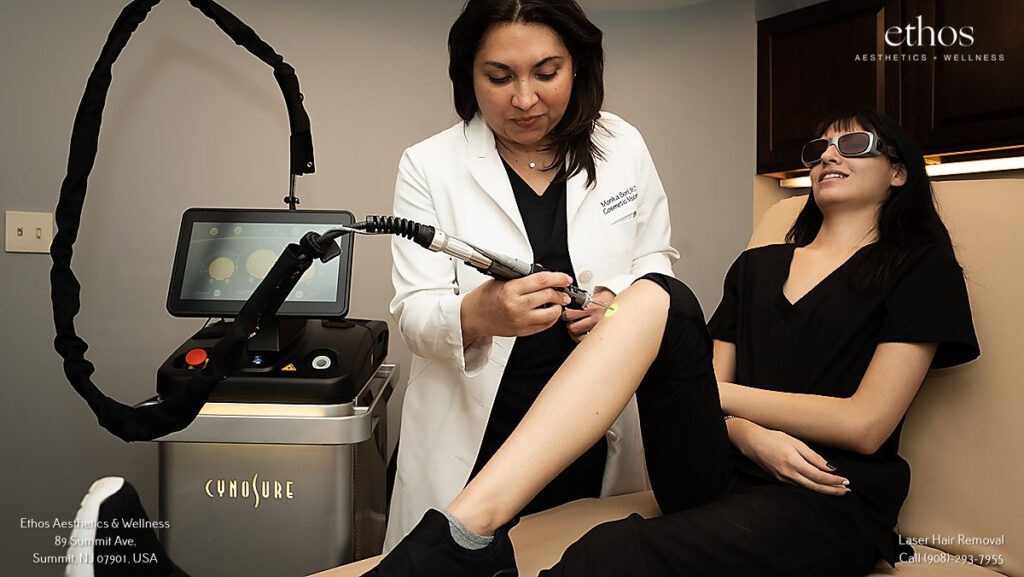Laser hair removal is often touted as a safe, effective, and permanent method to get rid of unwanted body and facial hair. However, the hard truth is that laser hair removal sometimes does not work for everyone.
In this guide, Dr. Soni, Ethos Aesthetics + Wellness’ medical director, will share insights on reasons why laser hair treatment may not work.
Why Isn’t Laser Hair Treatment Working?
The effectiveness of laser hair reduction depends on individualized treatment parameters, including skin type, hair type and color, hair growth cycle, and the presence of a tan.
While most patients can experience up to 90% long-term reduction in hair growth after a series of treatments, these can prevent a minority of patients from seeing similar results.
So why might laser hair removal fail for some people?
Why Isn’t Laser Hair Removal Effective for Some?
1. Hair Color and Skin Tone
Laser hair removal works by targeting the melanin pigment in hair follicles with quick pulses of intense laser light. This laser energy gets absorbed by the dark pigment, heating up the follicle and damaging it to prevent future hair growth.
So for the treatment to work, there needs to be high contrast between the color of the hair and the color of the skin.
The ideal candidates have very fair skin and noticeably darker coarse hair. If the hair color is too light such as white, gray, blonde or red, the laser will not be able to effectively target the weaker melanin pigment in those follicles.
Similarly, those with darker skin tones can find that the laser has difficulty distinguishing between the color of the hair and skin, leading to poor results.
Recent advancements in laser hair removal devices using longer wavelengths can better treat those with darker skin tones, but lighter hair continues to pose a challenge.
2. Natural Hair Growth Cycles

Another factor impacting results is the natural hair growth cycle of the body area being treated. As outlined by Dr. Soni, each hair follicle goes through three distinct phases:
- Anagen (Growth) Phase: This is when the hair is actively growing. This phase can last several years.
- Catagen (Transition) Phase: The hair stops growing and detaches from the blood supply before eventually shedding. This phase lasts 4-6 weeks.
- Telogen (Resting) Phase: The hair has shed while the follicle remains dormant for 2-3 months before restarting the cycle.
Laser hair removal only damages hair follicles that are currently in the active anagen growth phase. Follicles in the other phases will be missed and will need to be targeted in future treatments as they re-enter anagen.
If treatments are not timed properly based on the area’s specific growth cycle, they may fail to disable enough hair follicles to produce a noticeable reduction in hair growth.
3. Undiagnosed Hormonal Imbalances
For those suffering from excess hair growth on the face or body, especially women, Dr. Soni points out that the culprit could be an undiagnosed hormonal imbalance throwing off the hair growth cycle.
Common hormonal conditions leading to unwanted hair growth include:
- Polycystic Ovarian Syndrome (PCOS): PCOS is a common hormonal disorder in women that can cause facial hair growth and hirsutism in addition to irregular periods, acne, and weight gain. The elevated male hormones like testosterone overstimulate hair follicles.
- Menopause: The drop in estrogen and rise in testosterone levels during menopause can also trigger increased facial and body hair, particularly in older women.
- Congenital Adrenal Hyperplasia: This genetic condition manifests with excessive facial and body hair starting from a young age due to the adrenal glands producing higher levels of male hormones.
- Cushing’s Disease: Excess cortisol levels from Cushing’s can stimulate androgen receptors leading to hirsutism.
For women with hormonal imbalances like PCOS, laser hair removal can work to an extent by damaging the overactive hair follicles. However, the underlying hormonal dysfunction continues to fuel increased hair growth, limiting the long-term impact.
Consulting an endocrinologist to address the root hormonal imbalance is advised in these cases for best results.
4. Inadequate Pre-Treatment Preparation

To get the most out of each laser hair removal session, Dr. Soni stresses proper preparation of the treatment area. However, many patients fail to adequately prepare, limiting the effectiveness of the laser treatment.
Here are the key pre-treatment steps that must be followed religiously:
- Shaving: The area should be cleanly shaved 1-2 days prior to the appointment to ensure no surface hair remains to block the laser’s penetration down to the follicles.
- Avoid Plucking/Waxing: Plucking, waxing or epilating the hair should be avoided for 6 weeks pre-treatment as removing the follicle prevents the laser from targeting it.
- Stop Tanning: Any sun exposure or tanning should be halted at least 4-6 weeks prior to allow the skin to return to its natural baseline pigment for better laser precision.
Insufficient patient compliance with these guidelines between sessions is a common reason for suboptimal laser hair removal results.
5. Incorrect Laser Settings for Body Area
Another mistake Dr. Soni points out that is using the wrong treatment parameters and settings based on the area being targeted.
Different body parts have varying hair thickness, density and growth cycles. The practitioners must tailor the laser device settings, including wavelength, beam size, and cooling based on which body part is being treated:
- Face: Fine hair with a short growth cycle needs lower settings, higher frequency treatments.
- Underarms: Thinner hair also needs lower intensity settings to avoid burning the delicate underarm skin.
- Bikini: Coarse hair on the bikini line and genitals tolerates higher laser intensity due to the protective outer skin.
- Legs: The thicker leg hair can handle more aggressive treatment parameters to maximize impact.
Using a one-size-fits-all laser setup leads to poor long-term hair reduction on thinner facial and underarm hair, and risks burning and scarring delicate bikini skin. Customizing the parameters based on the body part characteristics is key for safety and optimal results.
6. Lack of Proper Practitioner Training
The laser hair removal provider’s skill and experience play a huge role in determining the efficacy and safety of the treatment. However, many providers lack the rigorous training needed to properly operate these devices.
This highlights the importance of getting your laser hair treatment done by highly experienced experts like Dr. Soni.
Here are the red flags indicating a poorly trained laser hair removal technician:
- Minimal knowledge of the principles behind laser hair removal and how to customize the settings based on skin and hair type.
- No medical credentials or supervised training under a licensed dermatologist.
- Rushing through the procedure instead of taking the time to methodically treat each area.
- Using a “one-size-fits-all” treatment approach instead of personalizing parameters.
- Failure to use cooling techniques to protect the skin from burns.
- Downplaying the threat of potential side effects.
Opting for an experienced provider who has extensive supervised training under a dermatologist and knows how to tailor the treatments can make a big difference in your results and safety. Don’t take shortcuts with your skin.
7. Medications Promoting Hair Growth

Certain medications can stimulate increased hair growth that may overcome the beneficial effects of laser hair removal treatments.
Some common drugs that are implicated in extra hair growth include:
- Steroids: Anabolic steroids, corticosteroids like prednisone, and androgen hormone therapy.
- Immunosuppressants: Cyclosporine, azathioprine.
- Anticonvulsants: Dilantin, phenobarbital.
- Minoxidil: This topical medication used for hair loss on the scalp can also accelerate hair growth elsewhere.
- Contraceptives: Certain birth control pills.
Checking with your prescribing physician to see if alternative medications are available is recommended. This allows the laser hair removal to work unimpeded to deliver the desired results.
8. Using Outdated Laser Technology
Laser hair removal technology has evolved considerably over the past decade, with newer devices capable of treating a wider range of hair and skin types.
Some signs that a clinic is using obsolete laser technology include:
- Older Nd:YAG lasers lacking adjustable settings based on skin tone and hair thickness.
- Ruby lasers that only work for very light skin.
- Diode lasers unable to treat darker skin.
- No advanced cooling systems to prevent burns.
- No integrated skin color sensors to automatically adjust laser parameters.
- No large spot sizes to treat bigger areas faster.
Opting for a clinic like Ethos Aesthetics + Wellness, which uses the latest generation of lasers, provides the best chance of clearing even difficult, coarse hair.
Experienced Team for Optimal Laser Hair Removal Results

When it comes to laser hair removal, the technology used can make a world of difference in achieving the best results.
Dr. Soni’s commitment to staying at the forefront of laser technology is what sets Ethos Spa apart in the field of laser hair removal, and this dedication can make a world of difference in achieving the best results.
Here are some reasons why Ethos Spa and Dr. Soni excel in the field of laser hair removal:
Cutting-Edge Laser Technology: At Ethos Spa, you’ll find the latest generation of laser devices. These devices are not only capable of treating a wide range of hair and skin types, but they also come with adjustable settings based on skin tone and hair thickness.
This customization ensures that each treatment is tailored to the individual, maximizing effectiveness.
Diverse Clientele: Ethos Spa and Dr. Soni cater to clients with varying skin tones. With advanced Nd:YAG lasers and other versatile technology, they can provide safe and effective treatments for everyone, regardless of their skin type.
Safety First: Safety is a top priority at Ethos Spa. Their state-of-the-art equipment includes advanced cooling systems to prevent burns and discomfort during procedures. Clients can have peace of mind knowing that their well-being is in capable hands.
Precision and Efficiency: The clinic’s modern laser devices feature integrated skin color sensors and large spot sizes. These features ensure precision and efficiency in each treatment, making the process faster and more comfortable for clients.
Experienced Technicians: Ethos Spa and Dr. Soni have a team of experienced technicians who understand the nuances of laser hair removal. They take the time to address individual concerns and provide customized treatments for the best possible outcomes.
If you’re looking for a clinic that offers the latest in laser hair removal technology, a commitment to safety, and a team of skilled professionals, Ethos Spa and Dr. Soni should be your top choice.
Their dedication to staying ahead in the field ensures that clients receive the best possible results. Say goodbye to unwanted hair and hello to confidence with Ethos Spa and Dr. Soni!
Frequently Asked Questions on Laser Hair Removal:
How long does laser hair removal last?
Laser hair removal can provide permanent hair reduction when performed properly over a series of treatments. Most patients see a 10-25% drop in hair growth after each session. While not 100% hair-free, most achieve 60-90% long-term hair reduction after an average of 6-8 sessions.
Does laser hair removal work for all skin types?
Laser hair removal works best for those with light skin and dark coarse hair. However, newer long-pulse Nd:YAG lasers containing integrated skin sensors and cooling can now also safely treat those with medium to dark skin tones. Patients with very fair hair still remain challenging.
What does laser hair removal feel like?
Most patients describe the laser pulses as rubber band snaps on the skin. Lasers equipped with advanced integrated cooling systems significantly reduce discomfort during treatment. Topical anesthetics can also be applied beforehand for high pain areas like the bikini line.
Why did my laser hair removal stop working?
If hair regrows after initial success with laser removal, causes can include hormonal conditions stimulating growth, natural hair cycling, inadequate device settings, or poor practitioner technique. Consulting a dermatologist experienced in hair removal can help determine the cause.
Does laser hair removal work on white/blonde hair?
Laser hair removal is minimally effective for white, gray or blonde hair since the weaker melanin pigment does not absorb enough laser energy to damage the follicle. Patients with dark coarse hair respond best. Electrolysis may be an alternative for lighter hair colors.
Is laser hair removal permanent after 6 sessions?
Most patients require 6-8 laser hair removal sessions spaced 4-6 weeks apart to successfully damage the majority of hair follicles and prevent regrowth. Periodic maintenance may be needed in hormonally sensitive areas. Only 80-90% permanent reduction is typically achievable, not 100% removal.
Why are multiple laser hair removal sessions needed?
Since hairs naturally grow in different cycles, not all follicles will be active and able to be targeted during any single treatment session. Multiple treatments are needed to disable hairs in all growth stages for long-term reduction.
How much does full body laser hair removal cost?
The average cost for full body laser hair removal is 00 to 00 depending on the number of sessions needed. Larger treatment areas like the legs and back will have higher costs than smaller delicate areas like the face and bikini region.
What is the best at-home laser hair removal device?
The Tria 4X and the newer Tria Smooth devices are FDA-cleared for at-home use. However, they may not disable coarse hair as effectively as the more powerful in-office lasers containing integrated cooling systems. At-home lasers work best for thinner lighter hair.
Can I tan between laser hair removal treatments?
Tanning should be avoided at least 4 weeks before and after each laser session. Exposure darkens the skin, decreasing the contrast between the pigment in the hair follicles and the surrounding skin. This can impact laser precision and increase adverse effects.
Does laser hair removal work on dark skin?
Laser hair removal used to be challenging for those with darker skin. However, new long-pulse Nd:YAG lasers containing specialized cooling systems allow safer, effective treatment of dark skin. An experienced technician also helps reduce side effects.
Why are multiple laser treatments needed?
Since not all hair follicles are actively growing at once, multiple treatments are needed to target the follicles in different stages of the growth cycle. On average 6-8 visits spaced 4-6 weeks apart catches the majority of hair follicles successfully.
How long after laser hair removal can I tan?
Exposure to UV rays can potentially trigger adverse effects on lasered skin. It’s best to avoid any tanning including self-tanners for 4-6 weeks after each laser session. The treatment area skin needs time to fully heal between appointments.
Does laser hair removal work on the face?
Laser hair removal is effective for removing facial hair, but requires careful precision and lower settings. The thinner vellus hairs and delicate facial skin need an experienced practitioner. For women with hormonal hair growth, combination treatment is recommended.
Does laser hair removal work better than electrolysis?
For large areas, laser hair removal usually works better than electrolysis since multiple hairs can be treated simultaneously. Electrolysis targets one hair at a time, requiring numerous repetitive sessions. So laser hair removal provides faster results.







